Apparently the world will never be the same again. Experts and average Joes keep telling us so. Only a handful of iconoclasts (or sociopaths depending on where you stand) are countering this narrative. They’re saying death count from the current pandemic is no worse than the flu. And they’re reminding us that previous pandemics such as swine flu and SARS were barely a blip. Both groups are warning against an economic shock. One warns against shock because that’s what happens when you have pandemics no matter how you try to manage it. The other wants against it because we’re shooting ourselves in both feet with our social and economic policies. Each side is doubling down on its argument using data on deaths and GDP, and speculation about the future of “social distancing.” I want to put these tragic and economically worrying numbers in perspective and see which side, if any, looks right. Are we losing perspective about big events?
Is it Really No Worse Than the Flu?
Let’s start with mortality and see if the no-worse-than-the-flu crowd have got it right. We’ll only be able to get to the bottom of the death counting issue once fuller figures come out for total and excess deaths. These will take at least a few more weeks and be adjusted for the rest of the year. Of course each side is claiming the death count is wrong. Iconoclasts are saying COVID-19 deaths are over counted (the “dying with vs dying of” question that infuriates experts for some reason). Experts are saying they’re under counted because COVID-19 isn’t always recognised.
But here are the official numbers for the UK to mid April, some more recent unofficial ones and a trending total.
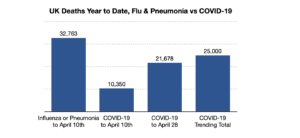
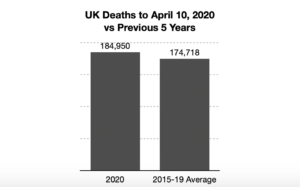
Looking at the raw numbers for the year so far COVID-19 looks no worse than the flu plus pneumonia. But 4 factors make it in many ways quantitatively and qualitatively worse:
- It’s additional. It’s not replacing this year’s flu. Looking at excess deaths it’s in addition to this year’s flu, so it roughly doubles the flu and pneumonia death count
- It’s new. We’re not used to it in the same way that we’re used to tens of thousands of souls dying every year from flu and pneumonia
- It’s recent. Most of those 20,000 plus deaths are happening in a couple of weeks as the current peak hits and passes
- It’s unknown. We don’t know how many people it could hit, whether and how much it will re-emerge as we loosen movement controls, or how to prevent or mitigate it with drugs, antibodies and vaccines
So the no-worse-than-the-flu crowd look like they’re under-estimating it. That is unless you recognise that the flu and pneumonia take tens of thousands of lives every single year, which we seem to accept as a reality of life with no lockdowns.
Is it Worse than Other Pandemics?
How about the iconoclasts’ other argument that we were told swine flu and SARS would be terrible and they were barely a blip. Well they do seem to be far off the mark here. Looking at total deaths, COVID-19 is an order of magnitude bigger than any recent pandemic.
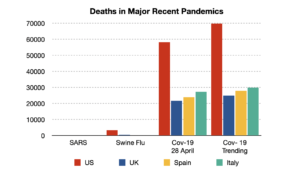
Swine flu was worse in one way in that it hit younger children much harder. But overall COVID-19 is a much bigger deal.
So is it Bad, as in World Changing Bad?
We’ve concentrated our fire on the no worse than the flu crowd and concluded that they’re underplaying it. Let’s turn our attention now to the commentators advising that the world will never be the same again. And let’s see if they’ve got a point.
To do this, let’s compare our current crisis to the biggest historical precedent for which we’ve got decent data, the Spanish Flu. And let’s see if economies dived and the world changed momentously after that.
Of course, we haven’t seen the end of COVID-19 yet, and there may be second and third waves. But look at the numbers of fatalities (I’ve had to make the axis 10x bigger than my previous chart to cover Spanish Flu).
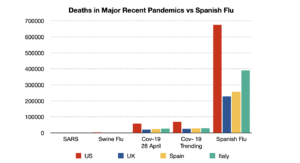
Spanish Flu was an order of magnitude bigger than COVID-19. It also killed the young and healthy disproportionately versus COVID-19. COVID-19 seems to hit the elderly, those with pre-existing conditions, and those who experience it in heavy doses.
Don’t forget that the population of these countries has doubled to tripled since 1918. When adjusting for population, the greater deadliness of Spanish Flu is even starker.
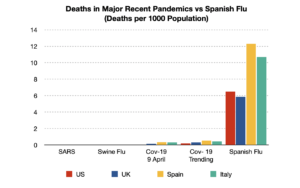
Do Pandemics Always Hammer GDP?
It’s difficult to isolate data to see how this massively larger pandemic affected world economies. European economies were rebuilding after a world war in which 20m people were killed and 21m wounded. Communism and the Russian revolution were transforming the east of Europe. The country worst hit by the Spanish Flu, India, had economic numbers that were hard to rely on.
The least polluted data set to assess seems to be the US. It lost relatively small numbers in the war, was less affected by communism, but still lost hundreds of thousands to the Spanish Flu.
Here’s what happened to US GDP from the start to past the end of the 1918-19 Spanish Flu pandemic.
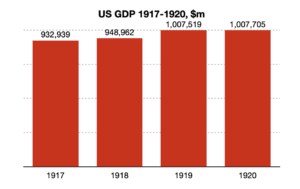
That’s right, it kind of just kept growing through the pandemic, and flattened after.
Arguments that this ultimately led to the great depression are a bit specious. The Spanish flu ended in the US in 1919. The Dow did have a brief downturn in 1920-21 a year after SF ended. Economists don’t even mention Spanish Flu in explaining its causes. The great depression didn’t even start until 1929.
So do pandemics inevitably cause depressions? History says they don’t.
Do Pandemics Change Society?
Changes to the world aren’t only about economics. Let’s have a look at how the Spanish Flu affected something that many speculate will never be the same again: attendance at large events. Here’s what has happened to US baseball attendances since 1900.
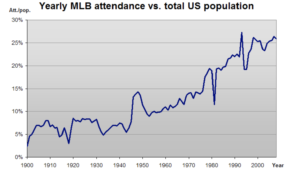
After the Spanish Flu, in the 1920s, attendances went up sharply in a golden age of baseball featuring the iconic Babe Ruth. They’ve been going up ever since with the exception of economic downturns, wars and player strikes.
So will the world never be the same again? Sure, in some ways. But it seems it will only change in the dramatic ways people are speculating if we deliberately and determinedly make it so, with some generous and maybe some self serving intentions. We had a much bigger and deadlier pandemic in 1918-19 and the world got back to action pretty finely.
Will we inevitably have a massive downturn? Sure we might. But there’s lots of things that correlate much more strongly with downturns, with more and better data behind them. These include the asset bubbles we’ve been creating since the start of the century, and the economic and trade restrictions we’re now seeing played out around the world. To lay the blame for a depression entirely on COVID-19, when there was only a slowdown after a much bigger pandemic and a world war, seems like one of those tricks politicians play when they want a go-to excuse for the less rosy results of their other policies.
Losing Perspective About Big Events
Things look big when they’re in front of our noses, especially if they’re new and we’re not used to seeing them. When that thing seems bad, it probably is bad. When it seems world changing, we need to stop and check because we don’t have a whole lot of everyday experience of world changing. So if we do check against something that was much bigger, and if that didn’t change the world that much, well this probably doesn’t need to either.
By Steve Hacking & Jim Powell




